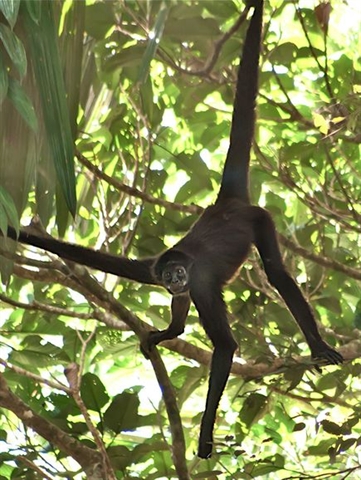cRios posted on febrero 02, 2012 10:17
Tomado de National Geographic News
Near-Extinct Monkeys Found in Colombian Park
Seeing rare species "was a very emotional moment," scientist says.

Photograph courtesy WCS
Christine Dell'Amore
National Geographic News
Published January 27, 2012
A new population of one of the world's rarest primates—the brown spider monkey (Ateles hybridus)—has been found in Colombia's Selva de Florencia National Park, conservationists announced this week.
During a recent survey, scientists found the brown spider monkey subspecies A. hybridus brunneus living within the park. (Also see "First Pictures: Live Snub-Nosed Monkeys Caught on Camera.")
That subspecies and another, A. hybridus hybridus, were previously known to live on either side of the Magdalena River, which passes through Selva de Florencia.
Considered critically endangered by the International Union for Conservation of Nature, the brown spider monkey has declined in its north South American range by at least 80 percent over the past 45 years, due mostly to hunting and habitat loss.
Based on the new survey, the scientists estimate that fewer than 30 individuals of A. hybridus brunneus exist per 0.4 square mile (1 square kilometer) of the park, according to Nestor Roncancio of the Wildlife Conservation Society's Latin America and Caribbean Program, who was on the expedition that found the monkeys.
The other subspecies wasn't found in the park during the recent survey.
Finding Monkeys an "Emotional Moment"
When the national park was formed in 2005, there had been no recent sightings of brown spider monkeys, and the species was considered locally extinct.
The region's rough landscape and history of armed conflicts made it difficult to conduct more extensive surveys, Roncancio said by email.
But in November 2011, a local farmer reported seeing a brown spider monkey—spurring scientists to organize a short expedition to find the species. (Also see "Rare 'Smiling' Bird Photographed in Colombia.")
"We were very surprised because, despite believing it was possible that the monkey was there, we knew it would be very unlikely to see it on such a short trip and due to the difficult terrain," Roncancio said.
"This was a very emotional moment."
The newfound population is the southernmost in the brown spider monkey's range and the only group of the species living in a protected area.
Roncancio and colleagues are now developing a conservation plan to protect the primates across their range.